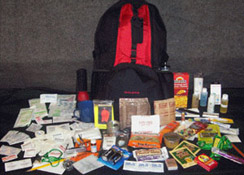Emergency Preparedness Kit
When a disaster strikes, your community emergency services and government agencies may not be able to respond to your needs immediately. Their buildings, equipment, personnel, communications, and mobility may be severely hampered by the event. They will be overwhelmed.
Experts warn that you should be prepared to be on your own for a minimum of three days and up to two weeks after a disaster. One of the most important elements of this preparedness is a disaster preparedness kit for your home or office. The contents of this kit will vary, but in every case it should contain the things you need to survive on your own.
Your Emergency Preparedness Kit should contain at least the following items:
- One gallon of water per person per day. This means at least three gallons of water per person for 72 hours. Experts now forecast that you should prepare to be on your own for up to two weeks.
- Sufficient non-perishable food for two weeks. Ideally, these foods will be lightweight and high in energy. If you pack canned foods, remember a can opener.
- Don’t forget water and food for your pets! Other good ideas include an extra leash, collar, Identification and copies of vaccination documents.
- Prescription and non-prescription medications. Include a spare set of glasses, if you need them.
- Battery powered portable radio. This may be your only source of information during a disaster.
- First Aid Kit (Hyperlink to First Aid Kit from EMS division). The small camping kits work well. Remember to get enough supplies for the number of people who may be using them.
- Personal hygiene items.
- Clothing and bedding. A spare pair of socks and a space saver blanket would be a minimum. Special items such as baby needs or contact lens supplies, etc…
- Personal comfort items. Books, games, personal electronics, etc…
► Emergency Preparedness Kit Checklist and Family Communication Plan
To keep your plan healthy, you should go over it with each family member at least once every six months. One way to do this is to make a night of it. Pick one night to go over the plan, practice escape routes and contact procedures, call your out of area contact (they’d probably like to hear from you), change the batteries in your smoke detector, and cycle the food and water in your Emergency Preparedness kit. This is a fun way to ensure that your family is prepared to react in the event of a disaster.
Your plan should include the following:
- What types of disasters can happen in your community and what to do in each type
- What you will do in an evacuation, including what to do with pets. Remember, most disaster shelters will not accept animals
- Where you will meet if separated. Pick one place outside your home and one place outside your community. Make sure that each family member knows the address and phone number of these locations
- Two escape routes from each room in case of a fire
- The location of the utility shut-off in your home, and procedures for using them
- Two escape routes from your community. Remember, roads may be blocked during a disaster
- Designate a friend or family member, preferably in another state, to be your out of area contact. When a disaster occurs, you can contact this person, who will act as a relay to other friends or family members
- Emergency phone numbers. These should include the numbers for police, fire, ambulance, out of neighborhood meeting site, and your out of area contact. Consider making cards with these numbers for each member of the family to keep with them.

